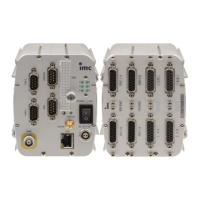© 2018 imc Test & Measurement GmbH
imc C-SERIES - Manual, Version 4 R 3 - 2018-10-19
33Measurement types
4.6.2.1 General remarks
Bridge channels are for taking readings from measurement bridges such as resistor bridges or strain
gauges. The channels are equipped as non-isolated differential amplifiers and can alternatively be used
for direct measurement of voltages.
There is a distinction among the following operating modes:
1. Target: Sensor
2. Full bridge
3. Half bridge
4. Quarter bridge
·
Target: Strain gauge
·
Full bridge with 4 active strain gauges in uniaxial direction
·
Full bridge with Poisson strain gauge in adjacent bridge arms
·
Full bridge with Poisson strain gauge in opposing bridge arms
·
Half bridge with one active and one passive strain gauge
·
Half bridge with 2 active strain gauges in uniaxial direction
·
Poisson half bridge
·
Quarter bridge with strain gauge
The following discussion, whenever it is in reference to terminal connections, circuitry etc., pertains
only to the C- 50xx module, and only the most general remarks on bridge measurement are applicable
for bridge measurement systems. Such generalized topics include instrument sensitivity and strain
gauge properties.
4.6.2.2 Bridge measurements with wire strain gauges (WSGs)
Strain in this sense refers to the ratio of a body's original length to the change in length due to a force
exerted upon it.
By selecting "Strain gauge" as the measurement target on the virtual index card "Inputs", common bridge
circuits and configurations for wire strain gauges (WSG) are offered for selection. The scaling can be
adjusted in terms of typical parameters for strain measurements such as the gauge factor or Poisson's
ratio, the transversal expansion coefficient.
If a WSG adheres to a test object, the strain on the object is transmitted to the bridge circuit. The
changes in the lengths of the bridge arms cause their impedances to change. There is a correlation
between the changes in length and the changes in resistance:
resistance of strain gauge
Gauge factor, describing the ratio of relative length change to
change in resistance
39
38
38
37
36

